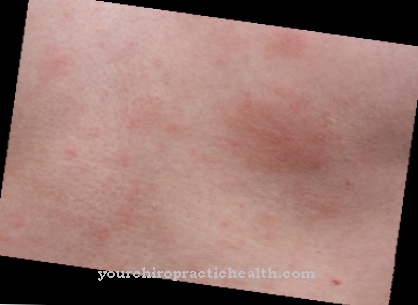Madonna fingers are thin, long-grown fingers that are the symptom of a parent disease. It is a variant of arachnodactyly that often occurs in the context of sclerodactyly. The treatment of Madonna's fingers depends on the primary cause, but usually includes physical therapy steps to maintain full or partial mobility.
What are Madonna Fingers?

© Köpenicker - stock.adobe.com
In the early days, statues of Mary were equipped with extremely thin fingers. The term Madonna finger comes from precisely these Madonna statues. Madonna fingers are unusually thin-looking fingers that are usually the symptom of a higher-level disease.
Thin fingers in themselves do not necessarily have pathological value. Disease is only present if the shape of the fingers is associated with other symptoms, above all with dermal symptoms such as waxy skin or with restricted mobility, such as can arise from crooked posture or pathological deposits in the finger joints. A crooked posture of the long, thin fingers fits in with the eponymous representation of Maria.
Depending on the cause, Madonna fingers are associated with more or less severe pain. Different clinical pictures come into question as the primary cause or underlying disease. Sclerodactyly is one of the most common symptoms associated with the Madonna's fingers. Madonna fingers are a form of arachnodactyly. Arachnodactyly does not necessarily have to have disease value, but in practice it can nonetheless refer to diseases.
causes
Arachnodactyls in the sense of long and narrow fingers can be a physiological variant of the shape. The expression of the Madonna's fingers is usually only used when arachnodactyly is a symptom of a disease. A disease associated with Madonna fingers is sclerodactyly, in which the fingers are not only exceptionally thin, but often additionally crooked.
In this disease, in addition to thin and long fingers, skin symptoms such as skin atrophy and restricted mobility, which can be attributed to painful swellings and contractures of the finger joints, appear. Apart from sclerodactyly, acrosclerosis can also be associated with Madonna's fingers, which in turn is associated with necrosis of the fingertips and the storage of calcium salts in the form of calcinosis.
In addition, Madonna's fingers can be the symptom of malformation syndrome. In this context, the long and narrow fingers are typical for Marfan's syndrome, for example. The syndrome causes a disease of the connective tissue through an autosomal dominant inherited mutation.
You can find your medication here
➔ Medicines for painDiseases with this symptom
- Marfan's Syndrome
Diagnosis & course of disease
Patients with Madonna fingers have unusually thin, mostly long fingers. As a rule, Madonna fingers are associated with other symptoms, which depend on the causal disease. Often, for example, there is additional scleroderma, in which fibrosis and sclerosis of the connective tissue of the skin develop.
The patient's skin is waxy and hard, especially in the context of progressive systemic scleroderma. For this reason, their thin fingers are typically restricted in their movement and are held in a curled, rigid posture. Sclerodactyly and acrosclerosis are often associated with Madonna fingers.
In such a case, painful cup necrosis appear on the Madonna fingers, which cause the tissue to die off. In addition, there is calcinosis in the area of the fingers. Often the cuticles of the patient are sclerotized and painful. The thin fingers can also be shortened due to acroosteolysis.
In the context of Marfan's syndrome, the Madonna fingers are associated with many other symptoms that largely affect the connective tissue. In this context, in addition to skeletal symptoms, cardiovascular symptoms and eye complaints should be mentioned.
Depending on the additional symptoms present, Madonna fingers can give the doctor a suspected diagnosis of various diseases. The doctor determines the symptom itself by means of visual diagnosis. In most cases, he will also use imaging methods such as X-ray imaging to accurately document the unusual shape of the finger. The prognosis for patients with Madonna's fingers depends on the causal disease.
Complications
As a rule, the patient suffers from untreated Madonna fingers an increasing and painful movement restriction of the hands. Other than that, Maddonenfingers themselves are straightforward. As a symptom of systemic sclerosis, however, they are extremely worrying, because this chronic disease can, in the worst case, lead to death undetected. The symptoms of the autoimmune disease, in which the skin changes due to an excess of collagen, initially develop very slowly and painlessly.
The associated hardening of the skin is incurable. Therapy can only relieve symptoms or slow the course of the disease. Since, for example, an infestation of the lungs or other internal organs can have serious consequences such as pulmonary fibrosis or heart failure, medical treatment for systemic sclerosis is inevitable.
The Madonna's fingers should be taken seriously as one of their first signs. However, because systemic sclerosis, a chronic autoimmune disease, is not easy to treat, it is imperative to consult an experienced doctor in order to avoid complications. The German Network for Systemic Scleroderma has therefore published a list of clinics and contact persons to make it easier for patients to find the right doctor.
When should you go to the doctor?
In most cases, Madonna fingers should definitely be examined and treated by a doctor. This disease usually leads to uncomfortable discomfort and restriction of movement for the patient and should therefore not be left untreated. A doctor must then be consulted if there is swelling and severe pain in the fingers and the affected person is restricted in his everyday life.
In most cases, the Madonna fingers are not the only symptom. Furthermore, it is not uncommon for discomfort to the eyes and thus reduced eyesight. Even with this symptom, a doctor must be consulted and treatment undertaken. In acute emergencies, the patient must contact an emergency doctor or a hospital to treat the Madonna's fingers. A weak heart can also be connected to the Madonna fingers and must never be left untreated.
Doctors & therapists in your area
Treatment & Therapy
An important aspect in the therapy of Madonna fingers is the preservation of mobility and thus manual dexterity. Most of the higher-level diseases with symptomatic Madonna fingers can, if left untreated, lead to severe impairments in everyday life. These impairments are prevented primarily through exercise therapy measures.
In physiotherapy, those affected exercise their fingers regularly and thus maintain their mobility. All further therapy steps depend on the respective superordinate disease. Dermal symptoms and pain symptoms can be reduced, for example, in the form of cold protection and greasy care. Since Madonna fingers are only a symptom, all treatment steps mentioned up to this point are to be understood as a symptomatic form of therapy.
In addition to the symptomatic treatment of the fingers, there is usually a causal treatment of the underlying disease that addresses the cause of the finger symptoms. Causal therapy is not possible for diseases such as Marfan's syndrome, as the disease is caused by a mutation. In such cases, treatment is solely symptomatic. In Marfan's syndrome, the prevention of severe scoliosis is crucial.
Outlook & forecast
In many cases, the Madonna fingers cause psychological complaints, as those affected do not feel attractive. This can also lead to inferiority complexes and reduced self-esteem. Those affected also suffer from restrictions in movement due to the unhealthy and crooked position of the fingers. The posture is rigid and does not allow dynamic movement, as would be the case with ordinary and healthy fingers. There is also pain in the fingers.
Not infrequently, the symptom of the Madonna's fingers also affects the eyes, causing eye discomfort. The eyesight can be reduced. If there are other changes to the skin in addition to the Madonna fingers, the heart can also be affected, so that cardiac insufficiency develops. An autoimmune disease can also develop, reducing the patient's life expectancy.
In most cases, treatment is symptomatic and aims to remove the mobility restrictions. Relatively good results can be achieved with the help of therapies. Further complications and complaints occur if the person affected is also suffering from scoliosis.
You can find your medication here
➔ Medicines for painprevention
Madonna fingers can only be prevented to the extent that the causal diseases can be prevented. With Marfan's syndrome in particular, one of the few preventive measures is genetic counseling during the family planning phase. Affected people can decide against having their own children in order not to pass the syndrome on. The extent to which such a decision is necessary for those affected can only be determined on a personal basis.
You can do that yourself
Fingers that appear abnormally thin and cramped are not only visually unattractive, they are also often associated with pain. There are, however, some self-treatment options and preventive measures. The top rule here is to avoid the cold, for example by using gloves or heat packs. In addition, the fingers must be kept in motion in order to counteract a permanently crooked, rigid posture, for example through physiotherapy exercises.
The aim of exercise therapy is to manually mobilize the joints and restore a natural flow of movement. The individual finger exercises should be carried out several times a day if possible. Regular hand massages also help. Electrotherapy and acupuncture are equally good options. Ginko extracts have shown significant results in long-term studies. A well-tried household remedy is to knead your hands with heated peeled millet. In general, it is important to ensure that the skin does not dry out.
Tobacco products should be avoided as nicotine exacerbates the clinical picture. Soaps are also not advisable because they usually damage the skin's protective acid shield. Frequent greasing of the fingers with lotions, creams or ointments that stimulate blood circulation prevents the skin from becoming wax hard.


.jpg)
























